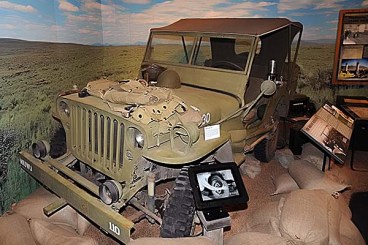
Jeep
The Army general purpose vehicle (GP pronounced Jeep) on display in the World War II exhibit at the High Desert Museum in Bend, Oregon, immediately caught our attention. In the late 1940s, Lee paid $500 for a war surplus Jeep. The Jeep displayed in the museum looks exactly like the one in which we neighbors anticipated weekend rides with Lee as he drove across rolling open space in the East Bay hills (now covered with homes) overlooking San Francisco Bay.
Comments from museum visitors in the model kitchen are as interesting as the exhibit. Seniors remember the chrome kitchen table and chairs. “This looks like (Grandma’s) (Mom’s) (our) kitchen.” “My mother used those.” “We had that.”
Younger visitors ask, “What’s this for?” (A manual egg beater.)
“What’s that?” (A glass dish with a knob in the center to manually squeeze fresh orange or lemon juice.)
“How do you use this?” (A manual can opener.)
Mine are all still dependable and never require batteries.
I remember victory gardens, curfews and blackouts, defense savings stamps and bonds and ration coupon books for groceries, gasoline and shoes on the home front. Lee remembers serving with the Navy in the South Pacific.
The parachute in the museum reminded me of the young sportswriter and amateur boxer my parents paid to babysit my younger brother and me when they spent an evening out to dinner and a movie or played cards with friends. When the U.S. entered the war, Dave enlisted in the Air Force and was assigned to B-17 bombing missions over Germany. Mom wrote Dave regularly and mailed him packages of chewing gum, chocolate bars and cigarettes. Wartime slogans encouraged citizens not to discuss troop movements, ship sailings or war work. Dave’s letters always mentioned my younger brother’s age: “So Ransom just turned 12.” “Wish Ransom a happy 14th birthday for me.” “Guess you are all looking forward to Ransom’s 16th birthday.”
“Dave knows Ransom is younger than I am. Why does he write that?” I asked Mom.
“That’s his code for the number of missions he’s flown,” Mom said. “After 24 missions, he comes home.”
Nearing Dave’s twenty-something mission, Mom told me she awoke in the middle of the night to see Dave standing in the bedroom doorway. She wrote Dave and asked if that date meant anything to him.
“Yes,” he wrote. “We were hit by shrapnel. Our turret gunner was killed, and we limped back to base.”
After the war, Dave gave Mom his parachute from which she sewed a peasant-style blouse for me and lingerie for herself. She cut Dave’s uniform down to a suit for Ransom. And Dave gave me his lapel pin shaped in the form of gold wings.

Where in the Bay Area hills did you live? I was in East Oakland during the war, and I remember all the things you wrote about. My Dad was a Block Warden.
LikeLike
Nice to hear from you Muriel! And thanks for reading this blog, a part of which was lifted from my recently published memoir, /His Daughter’s Remembrance/.
We lived in the hills above Richmond and El Cerrito.
Lynne
LikeLike